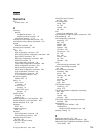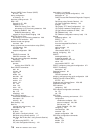focal point. An APPN end node can be a SOC node if it
supports the function to exchange management
services capabilities.
split horizon. A technique for minimizing the time to
achieve network convergence. A router records the
interface over which it received a particular route and
does not propagate its information about the route back
over the same interface.
spoofing. For data links, a technique in which a
protocol initiated from an end station is acknowledged
and processed by an intermediate node on behalf of the
final destination. In IBM 6611 data link switching, for
example, SNA frames are encapsulated into TCP/IP
packets for transport across a non-SNA wide area
network, unpacked by another IBM 6611, and passed to
the final destination. A benefit of spoofing is the
prevention of end-to-end session timeouts.
standard MIB. In the Simple Network Management
Protocol (SNMP), a MIB module that is located under
the management branch of the Structure of
Management Information (SMI) and that is considered a
standard by the Internet Engineering Task Force (IETF).
static route. The route between hosts, networks, or
both that is manually entered into a routing table.
station. An input or output point of a system that uses
telecommunication facilities; for example, one or more
systems, computers, terminals, devices, and associated
programs at a particular location that can send or
receive data over a telecommunication line.
StreetTalk. In the VIrtual NEtworking System (VINES),
a unique network-wide naming and addressing system
that allows users to locate and access any resource on
the network without knowing the network topology. See
also
Internet Control Protocol (ICP)
and
RouTing update
Protocol (RTP)
.
Structure of Management Information (SMI). (1) In
the Simple Network Management Protocol (SNMP), the
rules used to define the objects that can be accessed
by means of a network management protocol. (2) In
OSI, the set of standards relating to management
information. The set includes the
Management
Information Model
and the
Guidelines for the Definition
of Managed Objects
subarea. A portion of the SNA network consisting of a
subarea node, attached peripheral nodes, and
associated resources. Within a subarea node, all
network accessible units (NAUs), links, and adjacent
link stations (in attached peripheral or subarea nodes)
that are addressable within the subarea share a
common subarea address and have distinct element
addresses.
subnet. (1) In TCP/IP, a part of a network that is
identified by a portion of the IP address. (2) Synonym
for
subnetwork
.
subnet address. In Internet communications, an
extension to the basic IP addressing scheme where a
portion of the host address is interpreted as the local
network address.
subnet mask. Synonym for
address mask
.
subnetwork. (1) Any group of nodes that have a set of
common characteristics, such as the same network ID.
(2) Synonymous with
subnet
.
Subnetwork Access Protocol (SNAP). In LANs, a
5-byte protocol discriminator that identifies the non-IEEE
standard protocol family to which a packet belongs. The
SNAP value is used to differentiate between protocols
that use $AA as their service access point (SAP) value.
subnetwork mask. Synonym for
address mask
.
subsystem. A secondary or subordinate system,
usually capable of operating independently of, or
asynchronously with, a controlling system. (T)
switched virtual circuit (SVC). An X.25 circuit that is
dynamically established when needed. The X.25
equivalent of a switched line. Contrast with
permanent
virtual circuit (PVC)
.
synchronous. (1) Pertaining to two or more processes
that depend upon the occurrence of specific events
such as common timing signals. (T) (2) Occurring
with a regular or predictable time relationship.
Synchronous Data Link Control (SDLC). (1) A
discipline conforming to subsets of the Advanced Data
Communication Control Procedures (ADCCP) of the
American National Standards Institute (ANSI) and
High-level Data Link Control (HDLC) of the International
Organization for Standardization, for managing
synchronous, code-transparent, serial-by-bit information
transfer over a link connection. Transmission exchanges
may be duplex or half-duplex over switched or
nonswitched links. The configuration of the link
connection may be point-to-point, multipoint, or loop. (I)
(2) Contrast with
binary synchronous communication
(BSC)
.
SYNTAX. In the Simple Network Management Protocol
(SNMP), a clause in the MIB module that defines the
abstract data structure that corresponds to a managed
object.
system. In data processing, a collection of people,
machines, and methods organized to accomplish a set
of specific functions. (I) (A)
system configuration. A process that specifies the
devices and programs that form a particular data
processing system.
system services control point (SSCP). A component
within a subarea network for managing the
configuration, coordinating network operator and
710 MRS V3.2 Software User’s Guide


















